Showing Spotlights 721 - 728 of 2779 in category All (newest first):
 Nanofluidics is the study and application of fluids in and around geometries with nanoscale characteristic dimensions. The field of nanofluidics is not brand-new. Some issues associated with nanoscale fluidics have been occasionally dealt with by researchers in membrane science, colloid science, and chemical engineering for many decades. A recent review article provides a selected overview of the recent progress, rather than a comprehensive review of the entire field.
Nanofluidics is the study and application of fluids in and around geometries with nanoscale characteristic dimensions. The field of nanofluidics is not brand-new. Some issues associated with nanoscale fluidics have been occasionally dealt with by researchers in membrane science, colloid science, and chemical engineering for many decades. A recent review article provides a selected overview of the recent progress, rather than a comprehensive review of the entire field.
Jan 16th, 2018
 Optics and mesoscopic physics teams have discovered a new cooling mechanism concerning electronic components made of graphene deposited on boron nitride. The efficiency of this mechanism allowed them to reach electric intensities at the intrinsic limit of the laws of conduction. This new mechanism, which exploits the two-dimensional nature of the materials opens a 'thermal bridge' between the graphene sheet and the substrate. Researchers have demonstrated the effectiveness of this mechanism by imposing in graphene levels of electrical current still unexplored, up to the intrinsic limit of the material and without any degradation of the device.
Optics and mesoscopic physics teams have discovered a new cooling mechanism concerning electronic components made of graphene deposited on boron nitride. The efficiency of this mechanism allowed them to reach electric intensities at the intrinsic limit of the laws of conduction. This new mechanism, which exploits the two-dimensional nature of the materials opens a 'thermal bridge' between the graphene sheet and the substrate. Researchers have demonstrated the effectiveness of this mechanism by imposing in graphene levels of electrical current still unexplored, up to the intrinsic limit of the material and without any degradation of the device.
Jan 9th, 2018
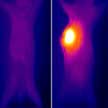 Researchers propose novel flexible Mn-doped zirconium metal-organic frameworks nanocubes for highly effective combination of microwave dynamic and thermal therapy against cancer. This is the first report of determining the microwave thermal conversion efficiency, which can be used to evaluate, compare, and predict the microwave sensitivity of different microwave-sensitive agents. More importantly, such Mn-ZrMOF nanocubes generate abundant reactive oxygen species of hydroxyl radicals under microwave irradiation.
Researchers propose novel flexible Mn-doped zirconium metal-organic frameworks nanocubes for highly effective combination of microwave dynamic and thermal therapy against cancer. This is the first report of determining the microwave thermal conversion efficiency, which can be used to evaluate, compare, and predict the microwave sensitivity of different microwave-sensitive agents. More importantly, such Mn-ZrMOF nanocubes generate abundant reactive oxygen species of hydroxyl radicals under microwave irradiation.
Jan 8th, 2018
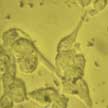 The role of artificial nanomotors integrated with therapeutic capabilities is a very promising field for clinical applications of medical nanotechnology. Researchers now have demonstrated the intelligent design of nanomotors with a single coating of ferrite, which act as a spacer layer as well as providing therapeutic potential by magnetic hyperthermia. These motors can be remotely maneuvered. The team also tackled the problem of magnetic agglomeration associated with ferromagnetic nanomotors, which limits their biomedical application.
The role of artificial nanomotors integrated with therapeutic capabilities is a very promising field for clinical applications of medical nanotechnology. Researchers now have demonstrated the intelligent design of nanomotors with a single coating of ferrite, which act as a spacer layer as well as providing therapeutic potential by magnetic hyperthermia. These motors can be remotely maneuvered. The team also tackled the problem of magnetic agglomeration associated with ferromagnetic nanomotors, which limits their biomedical application.
Jan 5th, 2018
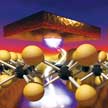 In trying to bring brain-like (neuromorphic) computing closer to reality, researchers have been working on the development of memory resistors, or memristors, which are resistors in a circuit that 'remember' their state even if you lose power. Now, scientists have discovered non-volatile memory effect in atomically thin 2D materials such as MoS2. This effect is similar to memristors or RRAM in metal oxide materials. These devices can be collectively labeled atomristor, in essence, memristor effect in atomically thin nanomaterials or atomic sheets.
In trying to bring brain-like (neuromorphic) computing closer to reality, researchers have been working on the development of memory resistors, or memristors, which are resistors in a circuit that 'remember' their state even if you lose power. Now, scientists have discovered non-volatile memory effect in atomically thin 2D materials such as MoS2. This effect is similar to memristors or RRAM in metal oxide materials. These devices can be collectively labeled atomristor, in essence, memristor effect in atomically thin nanomaterials or atomic sheets.
Jan 2nd, 2018
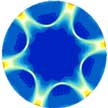 Topological superconductivity is an interesting state of matter, partly because it is associated with quasiparticle excitations, which are Majorana fermions, i.e. particles that are their own antiparticles, obeying non-Abelian statistics and therefore being of prime interest for topological quantum computing. A well-known example are chiral superconductors with px�ipy-wave pairing of electrons into a condensate of Cooper pairs, the carriers of superconductivity. Researchers suggest to consider mesoscopic samples, confined to the energetically favorable domain size, as a suitable platform to verify and potentially control the chiral domains.
Topological superconductivity is an interesting state of matter, partly because it is associated with quasiparticle excitations, which are Majorana fermions, i.e. particles that are their own antiparticles, obeying non-Abelian statistics and therefore being of prime interest for topological quantum computing. A well-known example are chiral superconductors with px�ipy-wave pairing of electrons into a condensate of Cooper pairs, the carriers of superconductivity. Researchers suggest to consider mesoscopic samples, confined to the energetically favorable domain size, as a suitable platform to verify and potentially control the chiral domains.
Dec 27th, 2017
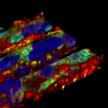 Crossing the blood-brain barrier (BBB) is the object of intensive research in nanotechnology and biomedicine for developing new therapies against brain cancer and for the treatment of neurodegenerative diseases. For this reason, it is extremely important to develop realistic models of the BBB, which mimic as most accurately as possible the in vivo environment. The development of high-resolution 3D-printing technologies has now enabled researchers to develop a realistic 3D bio-hybrid microfluidic model of BBB inspired by the in vivo neurovasculature.
Crossing the blood-brain barrier (BBB) is the object of intensive research in nanotechnology and biomedicine for developing new therapies against brain cancer and for the treatment of neurodegenerative diseases. For this reason, it is extremely important to develop realistic models of the BBB, which mimic as most accurately as possible the in vivo environment. The development of high-resolution 3D-printing technologies has now enabled researchers to develop a realistic 3D bio-hybrid microfluidic model of BBB inspired by the in vivo neurovasculature.
Dec 21st, 2017
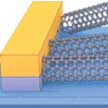 The detection of carbon monoxide (CO) in the air is a vital issue, as CO is a highly toxic gas and an environmental pollutant. Carbon monoxide is poisonous because it blocks the binding site for oxygen in hemoglobin. It is exactly this principle - a porphyrin ring with a central iron or cobalt atom that the poisonous gas attaches to - that can be used to implement sensors to warn against carbon monoxide. While carbon monoxide sensors have been extensively researched and commercialized, none make use of a molecule that can be voltage-activated using a newly reported method.
The detection of carbon monoxide (CO) in the air is a vital issue, as CO is a highly toxic gas and an environmental pollutant. Carbon monoxide is poisonous because it blocks the binding site for oxygen in hemoglobin. It is exactly this principle - a porphyrin ring with a central iron or cobalt atom that the poisonous gas attaches to - that can be used to implement sensors to warn against carbon monoxide. While carbon monoxide sensors have been extensively researched and commercialized, none make use of a molecule that can be voltage-activated using a newly reported method.
Dec 20th, 2017
 Nanofluidics is the study and application of fluids in and around geometries with nanoscale characteristic dimensions. The field of nanofluidics is not brand-new. Some issues associated with nanoscale fluidics have been occasionally dealt with by researchers in membrane science, colloid science, and chemical engineering for many decades. A recent review article provides a selected overview of the recent progress, rather than a comprehensive review of the entire field.
Nanofluidics is the study and application of fluids in and around geometries with nanoscale characteristic dimensions. The field of nanofluidics is not brand-new. Some issues associated with nanoscale fluidics have been occasionally dealt with by researchers in membrane science, colloid science, and chemical engineering for many decades. A recent review article provides a selected overview of the recent progress, rather than a comprehensive review of the entire field.
 Subscribe to our Nanotechnology Spotlight feed
Subscribe to our Nanotechnology Spotlight feed





